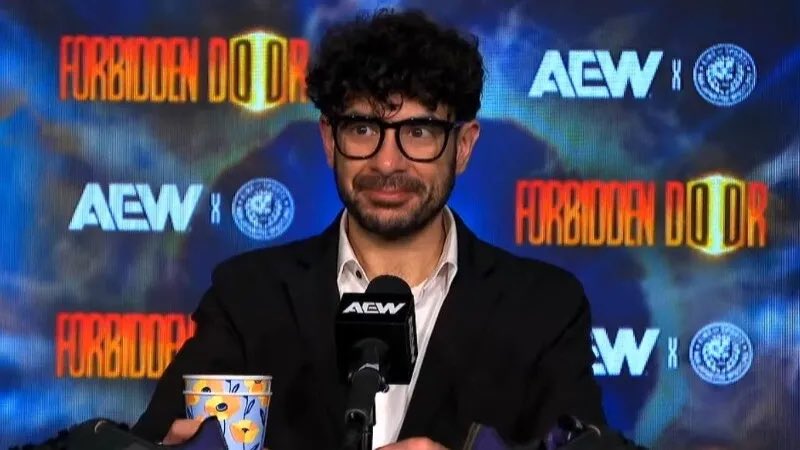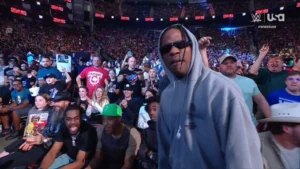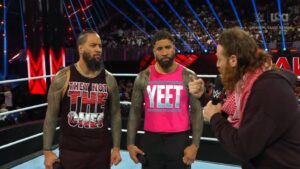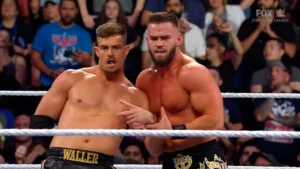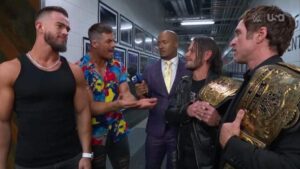In this series, James Staynings takes a deep dive into AEW’s short but impactful history, its present, and its future. In part 1, James discussed how AEW changed the wrestling industry (here). In Part 2, James discussed how AEW’s continued existence benefits wrestlers and fans alike (here).
Part 3 has been divided into two articles. One discusses the differences between in-ring action and storytelling (here). The other excellent in-ring action is compensating for wider issues in AEW creative (here). In a bonus article, James dissected the negative PR AEW receives from critics and the company’s response (here).
In this final part, James discusses AEW’s future. Including discussing the problems that AEW faces and questions Tony Khan will have to address.
More Than a Feeling
This year, AEW has outright told fans they are chasing “The Feeling”. Khan wants to restore the emotional investment that many AEW fans, including lapsed fans, associate with the promotion’s best work. “The Feeling” goes beyond great wrestling.
For me, that feeling isn’t just a sensation of spiritual nirvana that I described in Part 3 of this series. It’s a buzz that generates mental stimulation during the space between AEW shows. The gears in your head turn thinking about what is next. It’s about predicting, fantasy booking where the storyline goes next. Only to then tune in and experience joy because you got it right. Or surprise because they went in a direction you could not foresee. Then the process repeats itself.
It was never Utopian. AEW has always made mistakes or missteps. Whether it was The Pinnacle being the forerunner for The Undisputed Kingdom or The Cody-verse, there have been issues. However, the consistency of the rest made up for the flaws.
Throughout this year, it’s felt like “The Feeling” has been drip-fed back into the psyches of AEW fans again. However, not regularly enough. Not enough to dull the wider creative pains. It came back for a brief run under Samoa Joe as AEW World Champion before it sustained an injury.
After Double or Nothing, there has been some unpredictability about the company’s direction. It’s not restored yet. That will take months of consistency. Short-term, a restoration could impact fans, general perceptions and the drawing power of AEW. Long-term, if this is the only plan then it neglects the company’s other growing pains. Things AEW must address if they seriously want to compete with WWE on their level.
Side-Note- AEW’s Death
After this series, I’m going to (Terry Funk) retire discussion of AEW’s demise. Doomsday prophets, such as Jim Cornette, who from day one preached AEW would fail, will only stop when time proves them wrong. For now, they will just move the end day to another convenient point in the future.
The reality is this year they will get their big TV deal either with Time Warner Discovery or elsewhere. Folks who believe the company wants AEW gone selectively miss how many overruns Dynamite has had in recent months. TV ratings are another complex discussion that skews the reality of AEW’s success/failure.
Beyond the domestic, AEW will likely expand its international TV rights also. WWE’s move to Netflix benefits rather than hinders AEW. For example, there was chatter about WWE leaving The Score in Canada. This could open new possibilities for AEW in Canada where Rampage and Collision are only currently via streaming.
The final nail in AEW is the “like WCW” narrative (which I’ve discussed the financial aspects of elsewhere), this idea by the end of year five AEW should be profitable or it should go bust ignores not just wrestling history. WCW took six years to break even. It also ignores real shoot business reality.
WWE’s new home took six years to become profitable. Amazon took nine years. Uber, AirBnB or social media companies Reddit or Pinterest still exist and are running at a loss. Inevitably, presenting such evidence will mean the goalposts again get moved. Prophets don’t like being wrong and can never be wrong despite evidence to the contrary.
However, if like WWE or even TNA Wrestling, AEW weathers these storms, that conversation will (ironically) die.
Build The Backstage Team
AEW cannot grow just focused on providing the best wrestling. It’s their USP, but a USP must be sold to the public. Given the amount of misinformation related to AEW, the company needs to invest in other departments beyond the creative and in-ring aspects where it is strongest.
AEW needs to build its wider company infrastructure.
It cannot be understated that WWE’s recent success is not just down to creative. It’s because the right people are in the right positions behind the scenes. “The Paul Levesque Era” is built on the shoulders of media-orientated giants, Nick Khan and Chris Legentil.
Like WWE, Tony Khan’s company is not and cannot remain either a passion project or a mom-and-pop shop. Not if AEW wants to truly rival WWE and further its success. Khan has in the past and still currently receives criticism comparing him to Vince McMahon. Primarily because like Vince, Khan takes overarching responsibilities for creative and management backstage. Unlike Vince, Khan has roles beyond AEW and ROH with The Jacksonville Jaguars and Fulham FC. It’s too many fur hats to wear for one man at a time.
For AEW to take itself to the next level, the company doesn’t need a new top wrestling headliner who can elevate the promotion. Many fans and pundits would argue those potential stars are already there. MJF or Will Ospreay are two such potential headliners. What AEW needs is to build the machinery to package and present their wrestlers and the company itself as stars.
To compete with WWE, AEW needs a backstage organisation whose power, efficiency and connections can match WWE’s. To grow, Tony Khan needs to recruit, hire and build a team to do what one man alone cannot.
PR General- Marketing War
The evidence that AEW is “under attack” is obvious. Ignoring it might be the best short-term option. Acknowledging it, as I discussed in my article on the topic, has only legitimized some claims and given others the impression they’ve drawn blood. That’s only going to attract more sharks.
However, like in Western politics, ignoring it isn’t going to change the tactics being used by the opposition. The anti-AEW cottage industry or WWE’s PR department purposefully will act to keep their competition clipped. Multiple reports of how WWE has paid for fast ratings to leak to the press to imply AEW is performing worse than it is just one tactic.
Being constantly under fire and discredited by segments of the media and by the savvy tactics of your competitor, mud can and is still sticking because of repetition and persistence. It doesn’t matter if it’s true or a lie. If it’s said enough, it becomes fact.
AEW cannot just rely on a feeling. It’s got to go to war using different tactics and without Tony Khan leading the attack. Bluntly, Khan has become a divisive figure. Confirmation bias, the same as with The Young Bucks and the release of the All In footage, will just entrench wrestling fans deeper into their preconceived beliefs. AEW needs a PR and marketing general to lead this war.
They need an expert who can take over Khan’s challenger brand playbook. Add their plays and ideas to proceedings. Fight back with dirty tactics. While it’s important that AEW as a product remains and is an alternative to WWE, the reality is if in PR AEW plays by the rules it’s to their detriment. In business, being nice won’t stop your competition (as they are) from trying to hamstring you.
Merchandising Overhaul
To penetrate the zeitgeist in the way WWE has, AEW needs to up its merchandise game. This starts with t-shirts and other wrestling merchandise but needs to quickly escalate further to further crossover branding opportunities.
At present, AEW rightly gets criticism for its merchandise. Compare the design of Jacob Fatu’s wolf shirt to MJF’s first Wolf of Wrestling t-shirt. One looks rushed to the print shop, more bare bones and wrestling-orientated. The other one has a cool artistic design that I would wear on any day of the week. It also shows rather than tells non-WWE fans a lot about Fatu’s character.
Beyond The Acclaimed’s “Scissor Me Daddy” merchandise, a few examples of AEW merch have seized popular attention. Few seem destined to be iconic. Part of the issue is design. The other part, is promotion, marketing and improving sales efficiency.
An issue discussed online by some attendees of AEW shows is the limitations and inefficiency of AEW merchandise stands. Long lines and limited choices. Compared to WWE merchandise stands that are numerous, efficient and have range, it’s a wide chasm. It’s likely costing AEW money from directing selling.
Cutting AEW slack, the company is only five and built on The Elite’s DIY mentality. Also, WWE’s cultural legacy, its current hotness, and more importantly its executive’s connections to other industries are leading to a lot of cross-promotional merchandising.
NFL-themed championships and now they are working with Premier League Football side Manchester City on exclusive merchandise. It generates more money and brand recognition.
Now, AEW has begun this themselves with Reebok and their Young Buck and Brodie Lee-inspired sneakers. Over time, AEW should look to do more of this because there is the potential that WWE monopolises these avenues.
Recruit Beyond Wrestling
Khan should look for other departments to hire beyond just the small circle of wrestling-orientated production and backstage staff. Particularly those who have worked for WWE in the past. Fresh ideas and innovation can be found elsewhere.
The X Factor for AEW’s business model would be to secure their version of Jolly St Nick Khan. It’s undeniable Khan has been a game-changer in terms of WWE’s approach to business. It did not happen overnight that cities, both internationally and domestically, decided that paying WWE to come to them would benefit their economies. Someone had to have this idea, package it and sell it to them.
AEW is not in a place where it can, like WWE, ask for money for towns to come to shows. What they could use is someone with innovative ideas on how to grow the business, maximize their value and sell this to gain them maximum profit. Whether in rights fees, TV deals securing buildings or merchandising.
With someone who has connections across media platforms, journalism, celebrity culture, sports and various other crossover areas, it could give AEW access and insight to opportunities that otherwise would be off-limits.
Yet why stop at one person? If AEW could recruit their team. Or find such folks in global locations? Build AEW’s international reach. For example, the UK as a market is becoming more and more important to both AEW and WWE. There is a Battle for Britain taking place. Having an international expert may again help with international rights deals, as well as taking steps to tours of Europe and other continents.
Conclusion: It’s Never Been About One Man/Star
History and culture are obsessed with monomythical figures. Singular men and women who changed the world. Reality couldn’t be further from this fiction. Behind great individuals are teams and support networks that bring them to prominence.
WWE was not built by Vince McMahon alone. Many individuals, wrestlers, backstage personalities, financial backers, etc., brought change. Wrestlemania in concept might have been Vince’s, but its inspiration and even its name came from other sources. Its success was helped by MTV promotion and celebrity involvement, from Mr T to Cyndi Lauper.
Even in the aftermath, Hulk Hogan’s star power was not enough to keep Hulkamania running wild for so long. Besides a cast of credible supporting cast of villains and allies from Roddy Piper, Paul Orndorff or Randy Savage, backstage agents, marketing, and publicity stoked the fire. It was more than the team of Hulk and Vince.
Gilded ages, from the Attitude Era or the present Paul Levesque Era, have never been dependent on just singular men. Every star/figurehead is standing on the shoulders of giants. Many of whom remain faceless backstage characters.
As discussed, analysing the new era of WWE, Triple H hasn’t rebuilt the house of WWE, but instead, his success is built on Vince and the team Vince put into place. Tony Khan likewise isn’t a monolith. Khan cannot do everything himself. AEW is not a one-man operation. The Elite as EVPs pioneered the independent mindset of DIY. AEW is five and is too big to continue with this mentality.
To compete with WWE, AEW needs to go corporate. Not just in parody throughout storylines (as I discussed here). They need to beyond wrestling. Like WWE, they need the individuals and machinery to promote their myth. Then turn myth into more money as WWE has.
More From LWOS Pro Wrestling
Header photo – AEW – Stay tuned to the Last Word on Pro Wrestling for more on this and other stories from around the world of wrestling, as they develop. You can always count on LWOPW to be on top of the major news in the wrestling world. As well as to provide you with analysis, previews, videos, interviews, and editorials on the wrestling world. You can catch AEW Dynamite on Wednesday nights at 8 PM ET on TBS. AEW Rampage airs on TNT at 10 PM EST every Friday night. AEW Collision airs Saturday at 8pm Eastern on TNT. More AEW content available on their YouTube.


